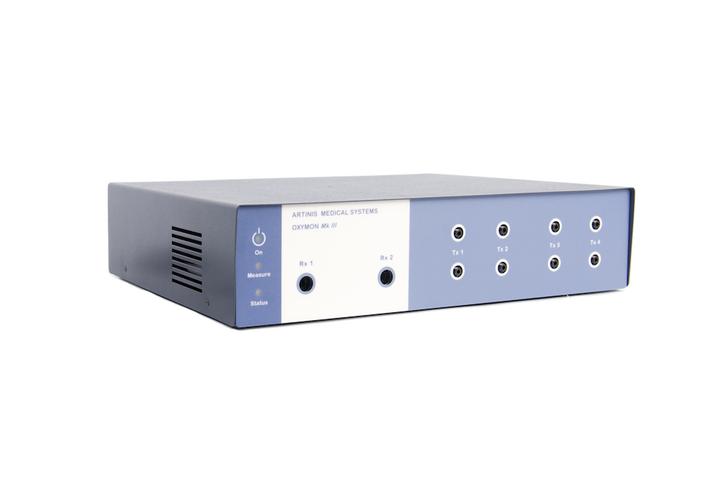
Publications using the OxyMon
Carbon monoxide exposure during exercise performance: Muscle and cerebral oxygenation
Aim: To investigate the effect of carbon monoxide (CO) in the inspired air as anticipated during peak hours of traffic in polluted megalopolises on cerebral, respiratory and leg muscle oxygenation during a constant-power test (CPT). In addition, …
DHA-rich oil modulates the cerebral haemodynamic response to cognitive tasks in healthy young adults: a near IR spectroscopy pilot study.
The impact of dietary n-3 PUFA on behavioural outcomes has been widely researched; however, very little attention has been given to their impact on brain functioning in physiological terms. A total of twenty-two healthy adults took part in this …
Docosahexaenoic acid-rich fish oil modulates the cerebral hemodynamic response to cognitive tasks in healthy young adults
A number of recent studies have assessed the impact of dietary omega-3 polyunsaturated fatty acids (n-3 PUFAs) on behavioral outcomes; however, very little attention has been given to their impact upon brain function in physiological terms. …
Muscle Oxidative Capacity: an Indicator of Functional Status in People With Multiple Sclerosis
PURPOSE: Evaluation of skeletal muscle oxidative capacity in people with multiple sclerosis (MS) using near-infrared spectroscopy (NIRS) and its relationship with measures of walking disability. METHODS: Muscle oxidative capacity was measured in an …
Noninvasive evaluation of skeletal muscle mitochondrial capacity with near-infrared spectroscopy: Correcting for blood volume changes
Near-infrared spectroscopy (NIRS) is a well-known method used to measure muscle oxygenation and hemodynamics in vivo. The application of arterial occlusions allows for the assessment of muscle oxygen consumption (mVO 2) using NIRS. The aim of this …
Orthostatic leg blood volume changes assessed by near-infrared spectroscopy
Standing up shifts blood to dependent parts of the body, and blood vessels in the leg become filled. The orthostatic blood volume accumulation in the small vessels is relatively unknown, although these may contribute significantly. We hypothesized …
Oscillations in cerebral blood flow and cortical oxygenation in Alzheimer's disease
In Alzheimer's disease (AD) cerebrovascular function is at risk. Transcranial Doppler, near-infrared spectroscopy, and photoplethysmography are noninvasive methods to continuously measure changes in cerebral blood flow velocity (CBFV), cerebral …
Repetitive strain injury: a novel focus on an ancient problem
Proefschrift Radboud Universiteit Nijmegen.
Short intermittent hypoxic exposures augment ventilation but do not alter regional cerebral and muscle oxygenation during hypoxic exercise
This study investigated the effects of four exposures to normobaric hypoxia (SIH group; FIO2=0.120, N= 10) or placebo-control normoxia (Control group; FI O2=0.209, N= 9) on cardio-respiratory responses to hypoxic exercise. Before and after the …
VO 2 on-kinetics in isolated canine muscle in situ during slowed convective O 2 delivery
The purpose of this study was to examine O 2 uptake (VO 2) on-kinetics when the spontaneous blood flow (and therefore O 2 delivery) onresponse was slowed by 25 and 50 s. The isolated gastrocnemius muscle complex (GS) in situ was studied in six …
Functional impairment of skeletal muscle oxidative metabolism during knee extension exercise after bed rest
A functional evaluation of skeletal muscle oxidative metabolism during dynamic knee extension (KE) incremental exercises was carried out following a 35-day bed rest (BR) (Valdoltra 2008 BR campaign). Nine young male volunteers (age: 23.5 ± 2.2 yr; …
The use of near-infrared spectroscopy in understanding skeletal muscle physiology: Recent developments
This article provides a snapshot of muscle near-infrared spectroscopy (NIRS) at the end of 2010 summarizing the recent literature, offering the present status and perspectives of the NIRS instrumentation and methods, describing the main NIRS studies …
Variability comparison of simultaneous brain near-infrared spectroscopy and functional magnetic resonance imaging during visual stimulation
Brain near-infrared spectroscopy (NIRS) is emerging as a potential alternative to functional magnetic resonance imaging (fMRI). To date, no study has explicitly compared the two techniques in terms of measurement variability, a key parameter …
TMS: A navigator for NIRS of the primary motor cortex?
Near-infrared spectroscopy (NIRS) is a non-invasive optical imaging technique, which is increasingly used to measure hemodynamic responses in the motor cortex. The location at which the NIRS optodes are placed on the skull is a major factor in …
Coherence between brain cortical function and neurocognitive performance during changed gravity conditions
Previous studies of cognitive, mental and/or motor processes during short-, medium- and long-term weightlessness have only been descriptive in nature, and focused on psychological aspects. Until now, objective observation of neurophysiological …
Effects of acetazolamide and dexamethasone on cerebral hemodynamics in hypoxia
Previous attempts to detect global cerebral hemodynamic differences between those who develop headache, nausea, and fatigue following rapid exposure to hypoxia [acute mountain sickness (AMS)] and those who remain healthy have been inconclusive. In …
Intra- and extra-cranial effects of transient blood pressure changes on brain near-infrared spectroscopy (NIRS) measurements
Brain near-infrared spectroscopy (NIRS) is an emerging neurophysiological tool that combines straightforward activity localization with cost-economy, portability and patient compatibility. NIRS is proving its empirical utility across specific …
Suppression of cerebral hemodynamics is associated with reduced functional capacity in patients with heart failure
This investigation elucidated the underlying mechanisms of functional impairments in patients with heart failure (HF) by simultaneously comparing cardiaccerebral- muscle hemodynamic and ventilatory responses to exercise among HF patients with various …
Cerebral blood flow and behavioural effects of caffeine in habitual and non-habitual consumers of caffeine: A near infrared spectroscopy study
Caffeine has been shown to modulate cerebral blood flow, with little evidence of tolerance to these effects following habitual use. However, previous studies have focused on caffeine levels much higher than those found in dietary servings and have …
Quantitative analysis of hemodynamic and metabolic changes in subcortical vascular dementia using simultaneous near-infrared spectroscopy and fMRI measurements
Subcortical vascular dementia (SVD) is a form of vascular dementia from small vessel disease with white matter lesions and lacunes. We hypothesized that hemodynamic and metabolic changes in the cortex during a simple motor task may reflect the …